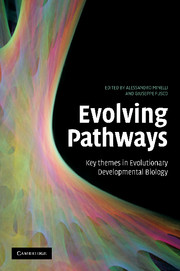Book contents
- Frontmatter
- Contents
- Contributors
- Preface
- Introduction: Pathways of change
- Part I Thinking about evolution by taking development on board
- Part II Evo-devo: methods and materials
- Part III Evolving diversity
- Part IV Evolving body features
- 17 Urbisexuality: the evolution of bilaterian germ cell specification and reproductive systems
- 18 Thoughts and speculations on the ancestral arthropod segmentation pathway
- 19 Evolution of neurogenesis in arthropods
- 20 Arthropod appendages: a prime example for the evolution of morphological diversity and innovation
- 21 Ontogeny of the spiralian brain
- Index
- References
17 - Urbisexuality: the evolution of bilaterian germ cell specification and reproductive systems
Published online by Cambridge University Press: 08 August 2009
- Frontmatter
- Contents
- Contributors
- Preface
- Introduction: Pathways of change
- Part I Thinking about evolution by taking development on board
- Part II Evo-devo: methods and materials
- Part III Evolving diversity
- Part IV Evolving body features
- 17 Urbisexuality: the evolution of bilaterian germ cell specification and reproductive systems
- 18 Thoughts and speculations on the ancestral arthropod segmentation pathway
- 19 Evolution of neurogenesis in arthropods
- 20 Arthropod appendages: a prime example for the evolution of morphological diversity and innovation
- 21 Ontogeny of the spiralian brain
- Index
- References
Summary
A key focus of evolutionary developmental biology (evo-devo) in recent years has been to elucidate the evolution of developmental mechanisms as a means to reconstructing the hypothetical last common ancestors of various clades. Prominent among such reconstructions have been proposals as to the nature of the mysterious Urbilateria, originally defined as the last common ancestor (LCA) of the extant Bilateria (Ecdysozoa, Lophotrochozoa and Deuterostomia) (De Robertis and Sasai 1996, Kimmel 1996). Indeed, drawings of this animal can now be found, as well as detailed information on the genetics and morphological processes that it used to construct its gut, heart, eyes, appendages, segments and body region identities (Gilbert and Singer 2006). Perhaps surprisingly, however, no explanations have yet been offered of how it might have achieved the successful reproduction that must have been necessary for it to give rise to still surviving lineages. This chapter will examine the comparative data available on the specification of bilaterian reproductive systems during development, with special emphasis on the cells containing the genetic hereditary material, the germ cells, and speculate on the possible gonad structure and reproductive strategy of Urbilateria.
Before proceeding, we should clarify our expectations as to what the study of extant species can tell us about Urbilateria. In this chapter, I wish to avoid suggesting that extant reproductive systems are simply variations on a defined metazoan reproductive ‘Bauplan’ theme; the great weakness of the current evo-devo approach stems from dilution of explanatory force with inappropriate fixations on strict, confining definitions of this kind (Scholtz 2004, 2005, Hübner 2005).
- Type
- Chapter
- Information
- Evolving PathwaysKey Themes in Evolutionary Developmental Biology, pp. 321 - 342Publisher: Cambridge University PressPrint publication year: 2008
References
- 9
- Cited by



